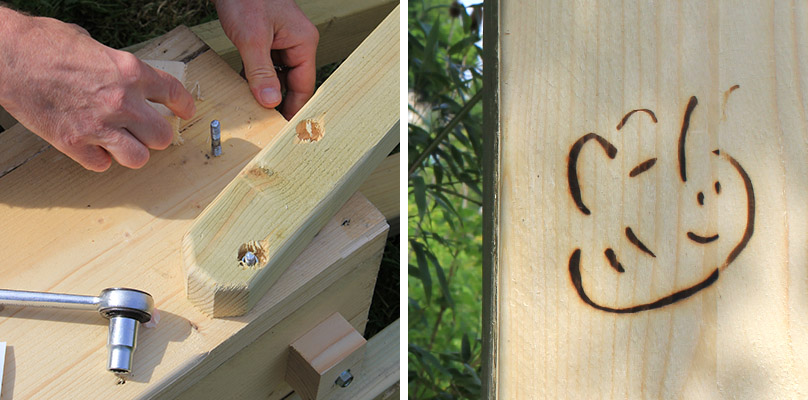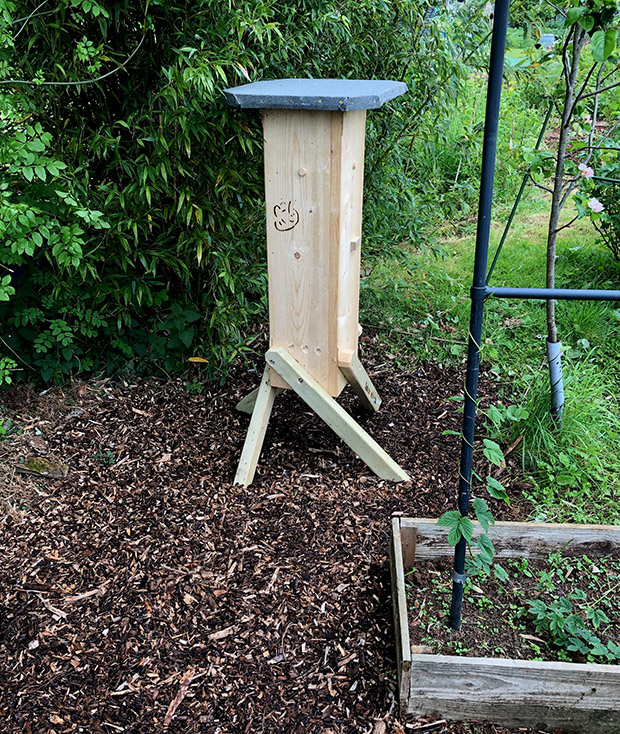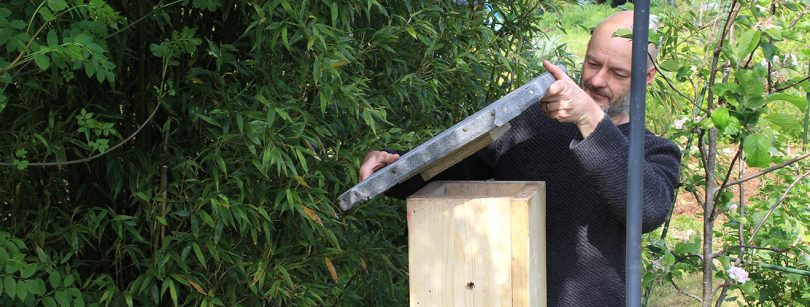We’ve always wanted more bees on the allotment. The poor creatures are in decline and, as renters of some prized land, feel it’s our duty to offer as much food and protection to them as possible. In return, Rich hopes they’ll pollinate his cider apple trees.
Thus far, the best we’ve been able to do is grow a few plants with nectar-packed flowers for them to munch upon, leave some areas as nature intended, and avoid the use of chemicals. We’ve always liked the idea of installing a beehive, but it just seems like too much fuss… the sting-proof clobber, the smoke and the constant attention all go against our lazy gardening ways.
We admittedly hadn’t done much research on keeping hives on an allotment, but if we had then there’s every chance we would’ve come across Kevin Hancock. Thankfully, Kevin contacted us.
Kevin makes beehives. But not the kind of beehives you see gown-wearing, smoke-squirting beekeepers poring over, eager for honey. Kevin’s bee hives provide a far more natural home for our nectar-loving friends. His business, ‘Gardeners Beehive’, is about protecting “bees for bees sake – not honey or money.” The hives, he says, are more like bird boxes. A self-regulating system where the bees thrive and get on with their bee-like business – without being sent to sleep every week by a jet of smoke. If you’re desperate to taste their honey you can install honey boxes, but that’s not the main aim. These hive are about saving our natural bee population.
Kevin is rightly proud of his natural hives – he makes them by hand and is keen to spread the word about their benefits. In order to help promote his business we agreed to house one on our allotment and write about it on this website.
The boxes are free standing at around four feet tall and easy to set up. You just need a spanner to open out the legs and fix them in place. The most important consideration is where you keep your hive. South facing is ideal, though not essential, but it will need as much protection from the shade as possible – under a tree or hedge is perfect. Ours has been given the dual shade of a large patch of bamboo and the hop arches.

The other vital consideration for your hive is clearing a flight path in front of the bees entrance holes, which are situated quite low down on the hive. Kevin suggests 3m to 5m should be sufficient and warns that any obstacles in the way could prevent the bees from swooping into their home. The position of our hive is at least 5m from the nearest hedge but weeds are always eager to rise in that area, so to prevent them from obstructing the flying bees we laid down some weed suppressing matting and covered it with wood chip. It’s the smartest, most natural runway we’ve seen.
Rich was also keen not to repeatedly wander into the bees flight path** so the hive and runway are angled away from his shed and working area, facing instead the rugby pitch beyond the hedge. (The rugger players ruin the allotment calm often enough with their sweary voices and we fully expect to hear even more sting-related expletives over the coming rugby season).
Kevin’s hives come with everything else you need to attract your first swarm of bees, which isn’t much: some ‘live biomass’ to make it more homely and some lure to attract them. We installed ours up in prime settling-in season, mid-May, so there’s a chance the bees might take up residence within a few weeks, but you can fix your hive up anytime of year – a little bit of ageing before spring will actually make it a more appealing residence for the bees.
We’re set up, primed and ready for the bees. We’ve even given the hive a name, Gordon, because in the words of Brian Blessed, “Gordon’s a Hive.” Now all we do is wait.
For more information on Gardeners Beehives visit gardenersbeehive.com

*One of our many excuses for not weeding
**We have painful, first hand experience of what can happen when you do this while photographing hives at a National Trust property








Hi, love the idea for attracting wild bees, there is a chap in Hampshire does a similar thing with a hollowed out tree trunk. Keep up the good work!
Beekeepers are troubled by this style of hive. The presence of varroa mite and bee diseases require regular inspection – you cannot do this with hives without movable frames. Swarming is another issue – these hives will swarm unhindered – the resultant swarms will bother your neighbours, close schools and often be killed unnecessarily by ignorant people. Get a proper hive, get on a course and join your local beekeeping group!
Seriously considering getting one…like you have lives the idea of ‘hosting’ honeybees, but don’t want the faff of ‘beekeeping’. How has your done, did you get any bees?
[…] often sees him flailing around in all sorts of spiky undergrowth and foliage. We’ve also got a wild bee hive down on the allotment which – any time soon* – will be full of lovely honey and obligatory […]
Some one made a comment about bee keepers been troubled by this type of hive and each to their own but don’t you think that having the roof ripped off your home loosing all the controled environment and sent being convinced that there is a fire and your furniture moved
around every seven to ten days in summer for the sake of honey money would that stress you out a bit modern beekeeping needs to be re addressed and stop thinking about money all the time and maximising productivity you must remember bees have been around a lot longer than we have and have done fine till we started putting them in boxes for profit
Well I have had my rant I’m also a natural bee keeper
Fantastic comment. I am with you 100%. Sick to my back teeth of greedy humans who have no thought for anything else other than profit. I am buying two natural hives. You are not ranting, you are just passionate about what you believe in, and I for one admire you for it!!!